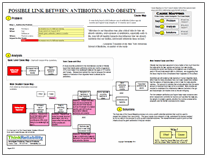In a previous blog, we wrote about a donated kidney that was accidentally thrown out rather than being transplanted. We began the root cause analysis investigation with the information that was available, but there were still a lot of open questions.
The Centers for Medicare & Medicaid Services (CMS) has released a report on the incident, which provides additional information we can use to update our Cause Map. We can update all areas of the investigation, including updating any additional goals that were found to be impacted. In this case, three employees had been placed on administrative leave. Since the time of the previous blog, four employees have had their careers impacted – one has resigned, one has been fired, one has had a title removed, and another has since returned from paid administrative leave. Additionally, there is a risk that the hospital may be removed from the Medicare program, another impact to the compliance goal.
 The report provides more specific causes, and evidence, regarding the incident. We know now that the kidney, which was to be transplanted, was instead thrown in a hopper by the circulating nurse. We can ask “Why” questions to add more detail. The kidney was thrown in the hopper because the contents of the slush machine were thrown in the hopper and the kidney was in the slush machine. It still isn’t clear why the kidney was in the slush machine in the donor’s operating room (rather than being transferred immediately to the recipient’s room), but more information regarding the disposal is now available.
The report provides more specific causes, and evidence, regarding the incident. We know now that the kidney, which was to be transplanted, was instead thrown in a hopper by the circulating nurse. We can ask “Why” questions to add more detail. The kidney was thrown in the hopper because the contents of the slush machine were thrown in the hopper and the kidney was in the slush machine. It still isn’t clear why the kidney was in the slush machine in the donor’s operating room (rather than being transferred immediately to the recipient’s room), but more information regarding the disposal is now available.
The nurse disposed of the hopper because she was unaware that the slush machine contained the kidney. The nurse had been on lunch break when the location of the kidney was announced and was not briefed on the status of the operation upon her return. There was no documentation on where the kidney was located, and the nurse assumed that it was in the recipient’s room. For reasons that are unclear (as it is usually the job of the technician who is responsible for the machine), the nurse decided to empty the slush machine while the operation was still ongoing. This appeared to be against procedure, but the procedure had “exceptions” according to staff, and was ineffective in this case. The technician that was responsible for the slush machine was exerting inadequate control, as the staff members have stated that no one noticed the nurse empting the slush machine. This also demonstrates inadequate control of the kidney, since there appeared to be no staff person responsible for the kidney itself.
Since the incident, the hospital has developed a procedure for intra-operative hand-off, which includes a briefing requirement for staff members who enter an operating room mid-procedure. Additionally, clarification has been provided that nothing will leave an operating room until the patient has left, post-procedure. Although the transplant program is still shutdown pending investigation, a recommendation that might reduce this type of problem in the future would be to ensure that a staff member is designated as responsible for any donated organs from removal to transplant.
To view the updated Cause Map and potential solutions, please click “Download PDF” above









